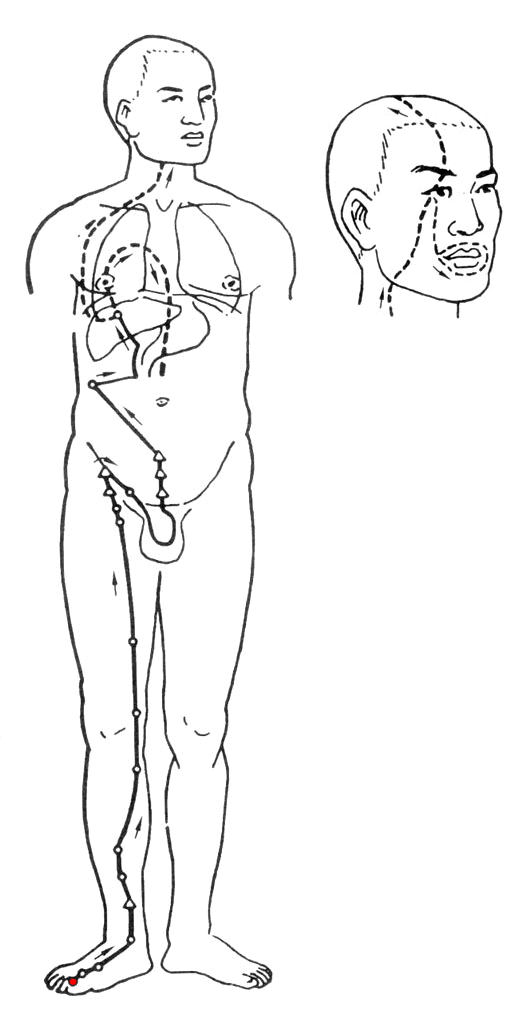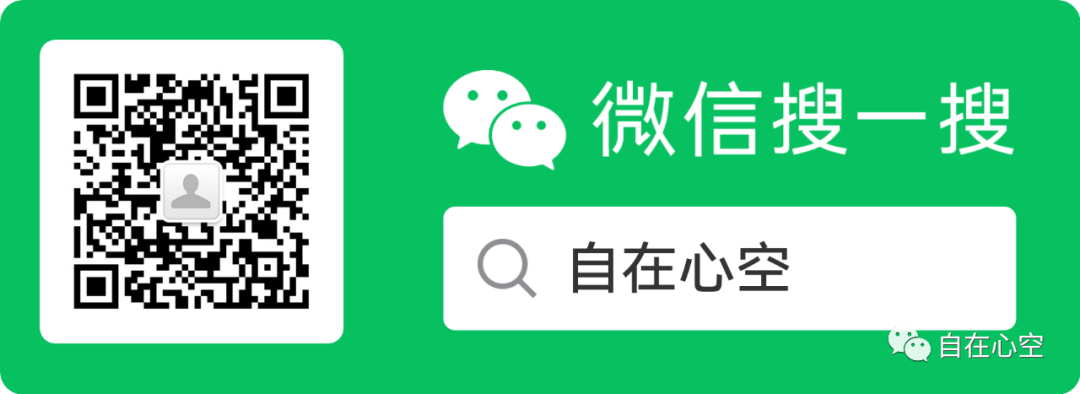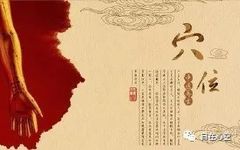1. Names of the Twelve Meridians
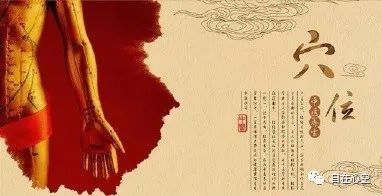
The twelve meridians, also known as the twelve primary meridians, along with the Ren (任脉) and Du (督脉) meridians, are collectively referred to as the fourteen meridians. The twelve primary meridians include: Shou Shaoyin Xin Jing (Hand Shaoyin Heart Meridian), Zu Shaoyin Shen Jing (Foot Shaoyin Kidney Meridian), Shou Jueyin Xin Bao Jing (Hand Jueyin Pericardium Meridian), Zu Jueyin Gan Jing (Foot Jueyin Liver Meridian), Shou Taiyin Fei Jing (Hand Taiyin Lung Meridian), Zu Taiyin Pi Jing (Foot Taiyin Spleen Meridian), Shou Taiyang Xiao Chang Jing (Hand Taiyang Small Intestine Meridian), Zu Taiyang Pang Guang Jing (Foot Taiyang Bladder Meridian), Shou Shaoyang San Jiao Jing (Hand Shaoyang San Jiao Meridian), Zu Shaoyang Dan Jing (Foot Shaoyang Gallbladder Meridian), Shou Yangming Da Chang Jing (Hand Yangming Large Intestine Meridian), Zu Yangming Wei Jing (Foot Yangming Stomach Meridian).
2. Why the Twelve Meridians are Named This Way
These twelve meridians are connected to twelve organs in the human body: Heart (心), Liver (肝), Spleen (脾), Lung (肺), Kidney (肾), Zhong (膻中, Pericardium), Gallbladder (胆), Stomach (胃), Large Intestine (大肠), Small Intestine (小肠), San Jiao (三焦), and Bladder (膀胱). Therefore, these meridians are named after the organs they connect. Among them, San Jiao refers to the entire chest and abdomen, while Xin Bao is a protective area for the heart, serving as a barrier for the heart, and the rest are relatively easy to understand. Remembering the names of these twelve organs is crucial; if there is discomfort in the body, one can identify which meridian passes through that area, leading to a corresponding diagnosis.
From the arrangement of the twelve meridians, they are divided into two groups: one group is based on the hands and feet, and the other group is based on Yin and Yang.
The division by hands and feet indicates that there are six meridians on the arms and six on the legs.
The division by Yin and Yang indicates that there are three Yin meridians on the inner side of the arms and legs, and three Yang meridians on the outer side of the arms and legs.
Shaoyin, Jueyin, Taiyin, Taiyang, Shaoyang, and Yangming represent the intensity of Yin and Yang Qi.
Shaoyin has the heaviest Yin Qi, so it is placed deepest on the inner side of the arms and legs.
Jueyin has lighter Yin Qi than Shaoyin but heavier than Taiyin, so it is placed in the middle.
Taiyin has the lightest Yin Qi, so it is placed on the outermost side.
Taiyang has the most abundant Yang Qi, like the midday sun, so it is placed on the outermost side of the arms and legs.
Shaoyang has slightly weaker Yang Qi than Taiyang, like the sun at eight or nine in the morning, so it is placed in the middle of the outer side.
Yangming has weaker Yang Qi than Shaoyang, like the dawn light, so it is placed on the innermost side of the outer side.
When using the meridians, one should always pay attention to the balance of Yin and Yang, which includes the balance between meridians, the balance between the body and meridians, and the balance between meridians and nature. The balance between the body and meridians requires one to choose meridians based on the body’s strength. For example, if the body is weak, it is best to first choose Yang meridians for massage to supplement the Zheng Qi (正气); Yin meridians should only be addressed after the Zheng Qi is replenished; if the body is strong, both Yin and Yang meridians can be massaged.
The balance of Yin and Yang between meridians and nature is related to the temperature of the four seasons. In summer, when Yang Qi is most vigorous, even those with weak bodies can also unblock Yin meridians at this time. The theory of Yin and Yang balance can also be applied to massage techniques; for Yin meridian massage, it is best to use a supplementing technique, while for Yang meridian massage, a draining technique can be used.
3. Supplementing and Draining in Massage
Generally speaking,massaging along the meridian is for supplementing, while massaging against the meridian is for draining.Light pressure during massage is for supplementing, while heavy pressure is for draining.Short duration of massage is for supplementing, while long duration is for draining.Small area of massage is for supplementing, while large area is for draining.In fact, these twelve meridians can be divided into three major groups, which each form a large circle around the limbs and return to the abdomen and chest. You only need to remember one group of four meridians, and remember the names of the organs connected to these four meridians. If one of these four organs becomes ill, you can start looking for pain points from the source of these four meridians, which is from the inner side of the arm leading to the hand, and gradually knead, tap, or scrape to smooth it out. This method not only has good effects but also prevents future complications and recurrences.What is the order of these three major meridian groups?Traditional Chinese Medicine divides them as follows:Group 1: Running on the outer side, is the Lung Meridian (肺经) → Large Intestine Meridian (大肠经) → Stomach Meridian (胃经) → Spleen Meridian (脾经)Group 2: Running on the inner side, is the Heart Meridian (心经) → Small Intestine Meridian (小肠经) → Bladder Meridian (膀胱经) → Kidney Meridian (肾经)Group 3: Running in the middle, is the Pericardium Meridian (心包经) → San Jiao Meridian (三焦经) → Gallbladder Meridian (胆经) → Liver Meridian (肝经)Additionally, when using meridians to treat diseases, it is important to choose the right time. Traditional Chinese Medicine believes that humans and the universe are interconnected as a unified whole; the human body is actually a microcosm of the universe, and all changes in nature (such as the alternation of day and night) are closely related to human life activities. In ancient China, a day was divided into 24 hours, which were further divided into 12 time periods, and Traditional Chinese Medicine corresponds each time period to one of the twelve meridians, as shown in the table below.
| Group | Time Period | Time | Meridian |
|
Group 1
|
Yin Time (寅时) |
3:00–5:00 |
Shou Taiyin Fei Jing (Hand Taiyin Lung Meridian) |
|
Yin Time (卯时) |
5:00–7:00 |
Shou Yangming Da Chang Jing (Hand Yangming Large Intestine Meridian) |
|
|
Yin Time (辰时) |
7:00–9:00 |
Zu Yangming Wei Jing (Foot Yangming Stomach Meridian) |
|
|
Yin Time (巳时) |
9:00–11:00 |
Zu Taiyin Pi Jing (Foot Taiyin Spleen Meridian) |
|
|
Group 2
|
Wu Time (午时) |
11:00–13:00 |
Shou Shaoyin Xin Jing (Hand Shaoyin Heart Meridian) |
|
Wei Time (未时) |
13:00–15:00 |
Shou Taiyang Xiao Chang Jing (Hand Taiyang Small Intestine Meridian) |
|
|
Shen Time (申时) |
15:00–17:00 |
Zu Taiyang Pang Guang Jing (Foot Taiyang Bladder Meridian) |
|
|
Yin Time (酉时) |
17:00–19:00 |
Zu Shaoyin Shen Jing (Foot Shaoyin Kidney Meridian) |
|
|
Group 3
|
Xu Time (戌时) |
19:00–21:00 |
Shou Jueyin Xin Bao Jing (Hand Jueyin Pericardium Meridian) |
|
Hai Time (亥时) |
21:00–23:00 |
Shou Shaoyang San Jiao Jing (Hand Shaoyang San Jiao Meridian) |
|
|
Zi Time (子时) |
23:00–1:00 |
Zu Shaoyang Dan Jing (Foot Shaoyang Gallbladder Meridian) |
|
|
Chou Time (丑时) |
1:00–3:00 |
Zu Jueyin Gan Jing (Foot Jueyin Liver Meridian) |
This division of the twelve meridians into three major groups makes it easier to use time periods for disease prevention and treatment.If there are discomforts in the Lung Meridian, Large Intestine Meridian, Stomach Meridian, or Spleen Meridian, it is best to massage and treat them in the morning or forenoon.If there are discomforts in the Heart Meridian, Small Intestine Meridian, Bladder Meridian, or Kidney Meridian, it is best to massage and treat them at noon or in the afternoon.If there are discomforts in the Pericardium Meridian, San Jiao Meridian, Gallbladder Meridian, or Liver Meridian, it is best to massage and treat them in the evening.For those with poor stomach health: You can find pain points on the Lung Meridian and Large Intestine Meridian on the outer side of the arm after waking up in the morning or during the forenoon, and then proceed to find pain points on the Stomach Meridian and Spleen Meridian on the legs, kneading them in order.For those with neck and shoulder pain or back issues: It is best to find pain points on the Heart Meridian and Small Intestine Meridian on the inner side of the arm at noon or in the afternoon, kneading them slowly, and then proceed to massage the painful areas of the neck and back.For those with liver issues: It is best to find pain points on the Pericardium Meridian and San Jiao Meridian in the middle of the arm in the evening, kneading and unblocking them, and then proceed to find painful or blocked areas on the Gallbladder Meridian and Liver Meridian on the legs for massage.For those in good health with sufficient Qi and blood: When unblocking meridians, the technique can be slightly heavier, and for painful or congested areas, tapping or scraping methods can be used. For those who are weak or have insufficient Qi and blood, there is no need to rush; the pressure during massage should be lighter, and the selected points and pain areas should be fewer, preferably choosing the first two meridians of each group (the meridians on the arms) for massage, while minimizing contact with the last meridians (Kidney Meridian, Liver Meridian, Spleen Meridian).
4. Diagram of the Twelve Meridians
1. Shou Taiyin Fei Jing (Hand Taiyin Lung Meridian)
The Lung Meridian of Hand Taiyin originates in the middle jiao, connects to the Large Intestine, follows the stomach, ascends to the diaphragm, belongs to the Lung, exits under the armpit, descends along the inner arm, travels before the Heart Meridian, descends at the elbow, follows the inner arm along the bone, enters at the wrist, ascends to the fish region, follows the fish border, and exits at the tip of the thumb; its branch exits from the back of the wrist directly to the inner side of the index finger, and exits at its tip.
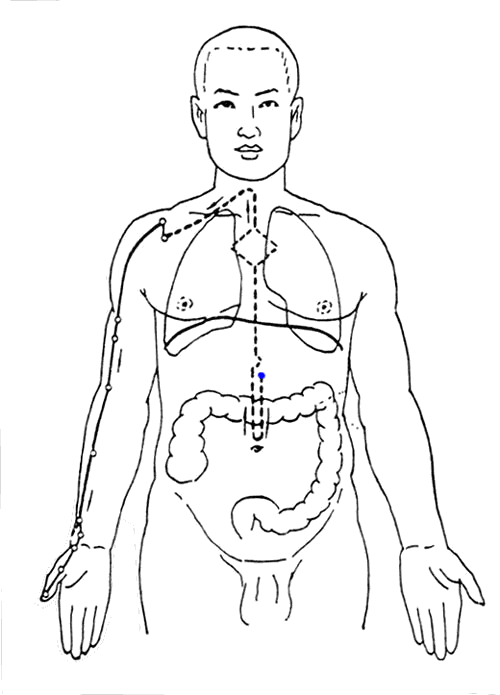
2. Shou Yangming Da Chang Jing (Hand Yangming Large Intestine Meridian)The Large Intestine Meridian of Hand Yangming originates at the tip of the index finger, follows the outer side of the finger, exits between the two bones of He Gu, ascends between the two tendons, follows the outer side of the arm, enters the outer elbow, ascends the outer front of the shoulder, exits before the acromion, ascends at the upper part of the humerus, descends into the chest, connects to the Lung, and belongs to the Large Intestine; its branch runs from the chest to the neck, enters the lower teeth, exits at the corner of the mouth, crosses the philtrum, and ascends to the nostrils.

3. Zu Yangming Wei Jing (Foot Yangming Stomach Meridian)
The Stomach Meridian of Foot Yangming originates at the intersection of the nose, descends along the outer side of the nose, enters the upper teeth, exits at the corner of the mouth, descends along the jaw, follows the Great Welcome, ascends in front of the ear, passes the master point, follows the hairline, reaches the forehead; its branch runs from the Great Welcome down to the Ren Ying, follows the throat, enters the chest, and belongs to the Stomach and connects to the Spleen; its direct branch runs from the chest down to the abdomen, enters the Qi Street.
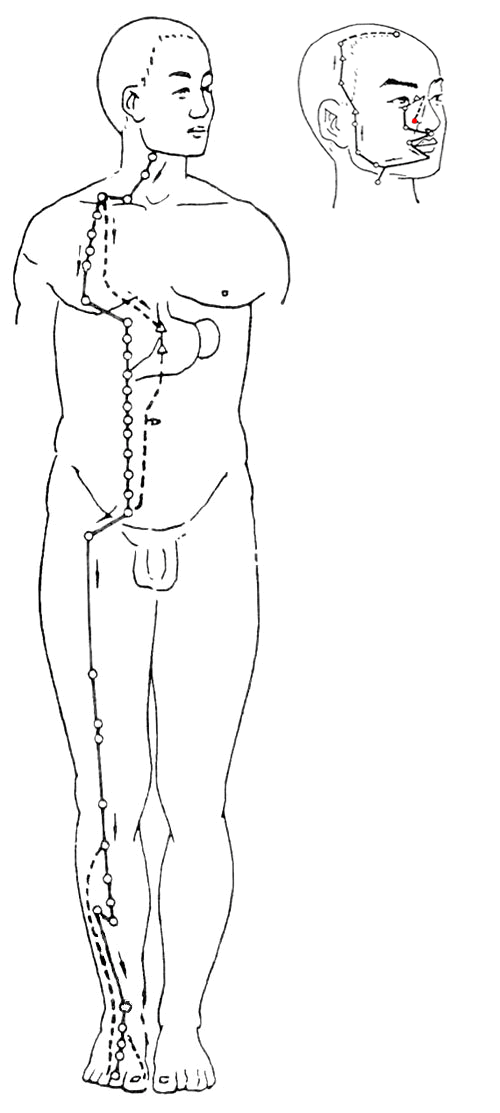
4. Zu Taiyin Pi Jing (Foot Taiyin Spleen Meridian)
The Spleen Meridian of Foot Taiyin originates at the tip of the big toe, follows the inner side of the toe, passes behind the kernel bone, ascends in front of the inner ankle, follows the inner side of the leg, crosses in front of the Jueyin, ascends the inner thigh, enters the abdomen, belongs to the Spleen and connects to the Stomach, ascends to the diaphragm, connects to the throat, and links to the root of the tongue, dispersing under the tongue; its branch runs from the Stomach, separates at the diaphragm, and enters the heart.

5. Shou Shaoyin Xin Jing (Hand Shaoyin Heart Meridian)
The Heart Meridian of Hand Shaoyin originates in the heart, exits from the heart system, descends at the diaphragm, connects to the Small Intestine; its branch runs from the heart system, ascends to the throat, connects to the eyes; its direct branch runs from the heart system, ascends to the Lung, exits under the armpit, descends along the inner arm, travels behind the Heart Meridian, descends at the elbow, follows the inner arm, reaches the tip of the little finger, and exits at its tip.
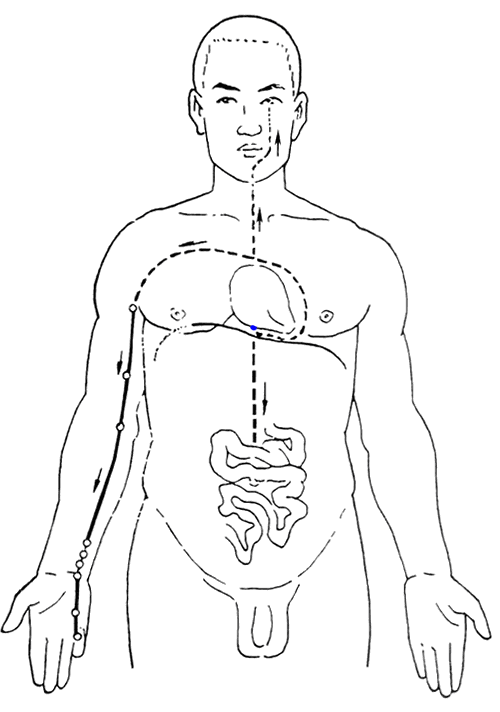
6. Shou Taiyang Xiao Chang Jing (Hand Taiyang Small Intestine Meridian)
The Small Intestine Meridian of Hand Taiyang originates at the tip of the little finger, follows the outer side of the hand, exits at the wrist, ascends along the inner side of the arm, exits between the two tendons at the elbow, ascends along the outer side of the arm, exits at the shoulder, encircles the shoulder blade, crosses the shoulder, enters the chest, connects to the heart, descends to the throat, and belongs to the Small Intestine; its branch runs from the chest, ascends to the neck, reaches the eyes, and enters the ear; its branch runs from the cheek, reaches the nose, and connects to the eyes.
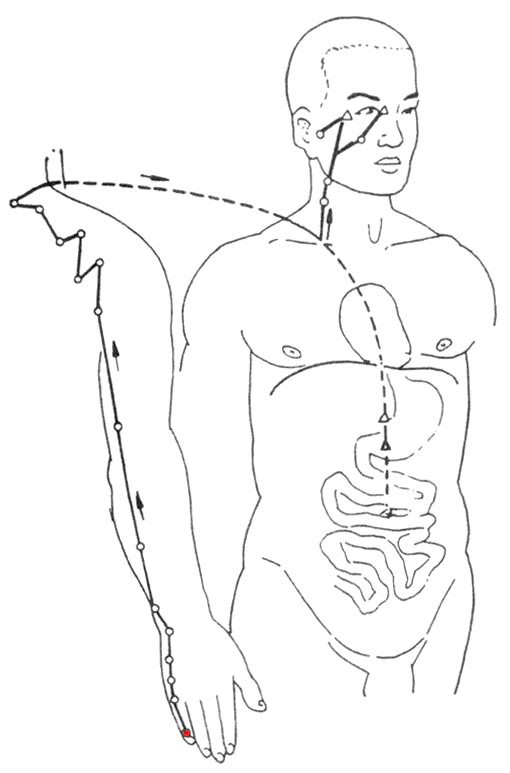
7. Zu Taiyang Pang Guang Jing (Foot Taiyang Bladder Meridian)
The Bladder Meridian of Foot Taiyang originates at the inner corner of the eye, ascends to the top of the head; its branch runs from the top to the upper corner of the ear; its direct branch runs from the top into the brain, exits at the back of the neck, follows the shoulder, connects to the spine, descends to the waist, enters the lower back, connects to the Kidney and belongs to the Bladder; its branch runs from the waist, descends along the spine, enters the buttocks, and connects to the knee; its branch runs from the inner thigh to the left and right, descends along the back, follows the hip joint, descends along the outer side, enters the knee, and descends to the outer ankle, following the foot bones, reaching the outer side of the little toe.
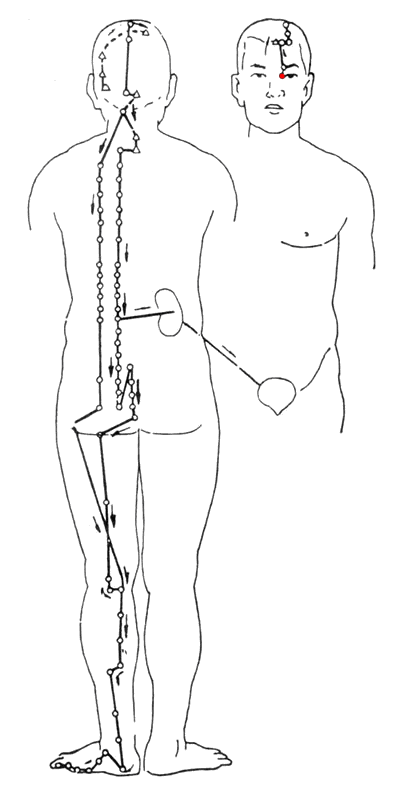
8. Zu Shaoyin Shen Jing (Foot Shaoyin Kidney Meridian)
The Kidney Meridian of Foot Shaoyin originates below the little toe, travels through the sole of the foot, exits below the heel, follows the inner ankle, enters the heel, ascends along the inner side, enters the inner thigh, connects to the spine, belongs to the Kidney and connects to the Bladder; its direct branch runs from the Kidney, ascends through the diaphragm, enters the Lung, follows the throat, and connects to the root of the tongue; its branch runs from the Lung, connects to the heart, and enters the chest.

9. Shou Jueyin Xin Bao Jing (Hand Jueyin Pericardium Meridian)
The Pericardium Meridian of Hand Jueyin originates in the chest, exits from the pericardium, descends at the diaphragm, connects to the San Jiao; its branch runs along the chest, exits at the side, descends three inches below the armpit, follows the inner arm, travels between the two tendons, enters the palm, follows the middle finger, and exits at its tip; its branch runs from the palm, follows the little finger, and exits at its tip.
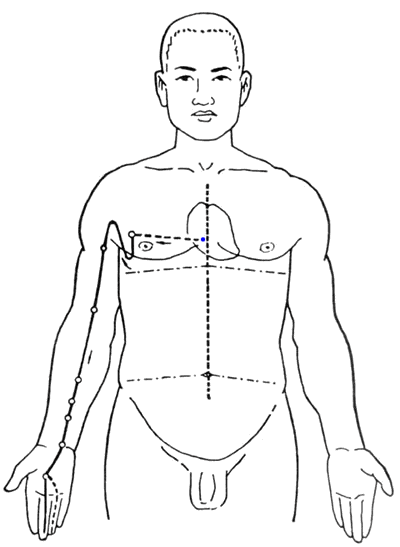
10. Shou Shaoyang San Jiao Jing (Hand Shaoyang San Jiao Meridian)
The San Jiao Meridian of Hand Shaoyang originates at the tip of the little finger, ascends between the two fingers, follows the outer wrist, exits between the two bones of the arm, ascends at the elbow, follows the outer side of the arm, crosses the foot Shaoyang, enters the chest, spreads in the Zhong area, descends at the diaphragm, and belongs to the San Jiao; its branch runs from the Zhong area, ascends to the neck, connects to the ear, exits at the upper corner of the ear, descends to the cheek, and reaches the inner corner of the eye.

11. Zu Shaoyang Dan Jing (Foot Shaoyang Gallbladder Meridian)
The Gallbladder Meridian of Foot Shaoyang originates at the inner corner of the eye, ascends to the head; its branch runs from the head to the back of the ear, follows the neck along the front of the Hand Shaoyang, reaches the shoulder, crosses the Hand Shaoyang, enters the chest; its branch runs from the back of the ear, enters the ear, exits at the front of the ear, reaches the inner corner of the eye; its branch runs from the inner corner of the eye, descends to the Great Welcome, connects to the Hand Shaoyang, reaches the mouth, descends to the cheek, and connects to the chest below the diaphragm, connects to the liver, and follows the ribs, exits at the Qi Street, encircles the hairline, and enters the hip joint; its direct branch runs from the chest, descends along the ribs, enters the hip joint, and descends along the Yang side, exits at the outer side of the knee, descends along the outer side of the foot, and enters between the little toe and the index toe; its branch runs from the foot, enters between the big toe, follows the big toe, and exits at its tip, and connects to the three hairs.

12. Zu Jueyin Gan Jing (Foot Jueyin Liver Meridian)
The Liver Meridian of Foot Jueyin originates at the tip of the big toe, ascends along the inner side of the foot, goes one inch from the inner ankle, ascends eight inches, crosses behind the Taiyin, ascends along the inner thigh, enters the lower abdomen, connects to the Stomach and belongs to the Liver, ascends through the diaphragm, spreads in the ribs, follows the throat, ascends to the head, connects to the eyes, and exits at the top of the head, where it meets the Du Meridian; its branch runs from the eyes, descends along the cheek, encircles the lips; its branch runs from the Liver, ascends through the diaphragm, and enters the Lung.
